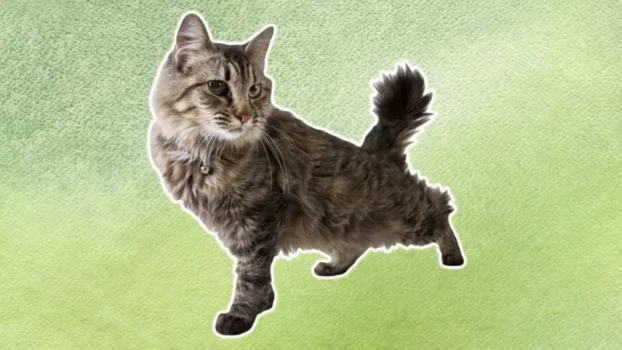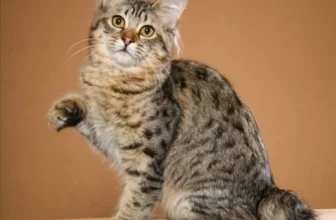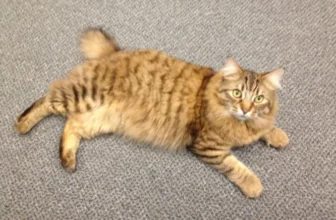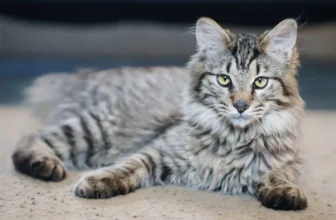It’s no secret that cats have been inexplicably adored by humans for thousands of years, but it wasn’t until the emergence of feline exhibition shows that we began to appreciate them on a whole new level. These shows allow breeders and cat lovers to gather and showcase their feline friends, compete with other breeds, and ultimately elevate the status of the beloved housecat to that of esteemed champion. One such breed that has made a significant impact in the realm of feline exhibitions is the American Bobtail. This unique and charismatic breed has a storied history, distinguishing characteristics, and has left its pawprints all over the world of competitive cat shows. In this article, we’ll delve into the fascinating world of American Bobtails and their role in feline exhibition shows.
The Emergence of Cat Shows
Cat shows have been around for more than a century, starting in Europe in the late 1800s. These exhibitions were an opportunity for feline enthusiasts to showcase their cats and compare them to other breeds. In 1895, the first cat show was held in Madison Square Garden in New York City, and it was a resounding success. Since then, cat shows have become increasingly popular, with thousands of shows being held worldwide each year.
The judging criteria for cat shows has evolved over the years, with early shows focusing solely on the cats’ physical appearance. However, in recent years, more weight has been given to aspects such as temperament, behavior, and health to determine the overall winner of the show.
Throughout the history of cat shows, certain breeds have emerged as favorites among judges and audiences alike. One such breed is the American Bobtail. The breed’s unique appearance and spirited personality have gained it a following among cat enthusiasts across the world.
The American Bobtail’s journey to becoming a recognized breed in cat shows was not easy, however. The breed’s ancestors are still somewhat of a mystery, but it is believed that they were originally found among feral cat populations and selectively bred to produce the distinctive bobtail. Native American legends also offer stories about bobtailed cats, leading some to speculate that the breed may have its roots in indigenous feline populations.
Today, the American Bobtail has become a fixture in the world of cat shows. Its distinct physical features, such as its short, bobbed tail and sturdy body, set it apart from other breeds. But it’s not just the breed’s physical appearance that has made it a popular contender in cat shows. The American Bobtail is known for its friendly and affectionate personality, making it a joy to have around in the home.
The emergence of cat shows has provided cat breeders and enthusiasts with a platform to share their love of cats and showcase the unique qualities of each breed. The American Bobtail’s rise to popularity within the cat show community is a testament to the breed’s distinctive appearance and lovable temperament.
American Bobtail’s Early Beginnings
The history of the American Bobtail breed is shrouded in mystery and legend, with various theories circulating about its origin. One theory suggests that the breed was brought over by early settlers who arrived in America. Another theory points to the breed’s Native American origins, with some sources citing the breed’s striking resemblance to the bobcat, a revered figure in many tribal legends.
American Bobtail’s Ancestry
Some breeders have been able to trace the American Bobtail’s ancestry back to a male brown tabby kitten acquired by John and Brenda Sanders in the late 1960s from an Arizona reservation. The kitten had a short tail and was believed to have some wildcat blood in him. The couple then bred him with a local female cat, which produced a litter of kittens with short tails like their father. They eventually moved to Iowa, where they continued to breed American Bobtails, perfecting their characteristics over time.
Interestingly, the American Bobtail’s short tail is not due to a genetic mutation, as is the case with the Manx or Japanese Bobtail. Instead, it is caused by a natural genetic mutation that occurred within the breed’s bloodline. It is also worth noting that the breed is distinct from the Pixie-bob, which is a hybrid breed that was created by crossing American Bobtails with other breeds such as the Bengal and the Abyssinian.
American Bobtail’s Appearance and Personality
American Bobtails are known for their striking appearance, with a short, fluffy tail, rugged appearance, and expressive eyes. They have a strong and muscular body, with hind legs that are slightly longer than their front legs. They come in a wide variety of colors and patterns, including tabby, calico, black, and white.
Aside from their unique appearance, American Bobtails are also known for their friendly and outgoing personalities. They are social cats that crave attention and affection from their human companions. They are also highly intelligent and love to play, making them a great choice for families with children or other pets.
So, whether the American Bobtail’s origin is rooted in Native American folklore or early settler history, it is undoubtedly a unique and fascinating breed that has made a significant impact in the world of feline exhibition shows today. For more information about the breed’s ancestry and evolution, visit our article on American Bobtail’s Ancestry.
American Bobtail Breed Characteristics
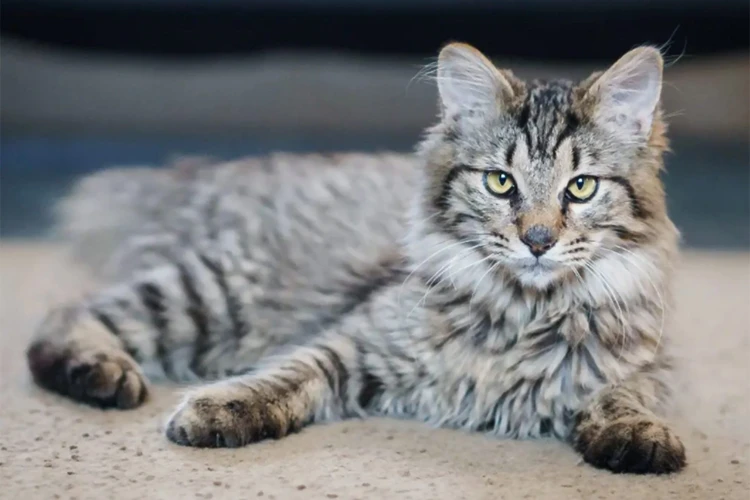
The American Bobtail breed is known to possess a unique set of characteristics, setting them apart from other feline breeds. The breed has been developed over time to hold certain physical and temperamental attributes that make them popular amongst cat lovers worldwide.
Physical Attributes: American Bobtails are medium to large-sized cats that possess a muscular body, prominent chest, and broad shoulders. Their hind legs are longer than their forelegs, giving them a distinctive wild appearance. One of the most prominent features of the American Bobtail is their short, bobbed tail, which is the result of a natural mutation. The length of their tails varies, with some cats having only a stump, while others may have a tail up to two-thirds of the length of a typical cat’s tail. Their heads are broad, with a squarish muzzle, and their eyes are almond-shaped and can be any color.
Temperament and Personality: The American Bobtail is known to be an intelligent, loyal, and affectionate breed. They are highly social and are known to be great companions for families, including children and other pets. They are also highly adaptable, making them suitable for both indoor and outdoor living. American Bobtails are known to be active, playful, and curious, making them easy to train for activities like fetch and walking on a leash.
Coat Types and Colors: The American Bobtail breed’s coat is short or medium-long, with a woolly undercoat and a soft, silky topcoat. The texture of their coats is waterproof, which enables them to adapt easily to different weather conditions. The breed comes in various colors and patterns, including white, black, brown, silver, cream, and red, among others. They can also have different patterns, such as tabby, tortoiseshell, and bi-color.
The American Bobtail’s unique characteristics make them a breed that is highly prized by cat lovers worldwide. Their wild appearance, intelligence, loyalty, and adaptability, make them an excellent choice for those looking for an affectionate and versatile feline companion.
As per Native American legends, Bobtails have been around for over 1,000 years. However, it wasn’t until the 1960s that the first registered American Bobtail was born. Since then, the breed has become increasingly popular, and their influence can be seen in feline exhibitions worldwide. The American Bobtail’s wild appearance, coupled with their friendly personality, makes them stand out amongst other breeds in cat shows. Many famous historical figures have been known to have American Bobtails as pets, proving the breed’s popularity over time. To learn more about the evolution of the American Bobtail breed, check out this article. The American Bobtail’s influence in feline exhibitions is ever-increasing, with owners and breeders proud to showcase their unique attributes. To learn more about the American Bobtail breed’s impact on feline shows, visit this page.
Physical Attributes
The American Bobtail is a medium to large-sized cat breed with a muscular, athletic body that exudes power and agility. They usually weigh between 7 to 16 pounds and can stand up to 12-18 inches tall at the shoulder. Their hind legs are slightly longer than their front legs, which contributes to their unique, wild look.
One of the most notable features of this breed is their short, fluffy, and bobbed tail. This distinctive tail is typically 1/3 to 1/2 the length of an average cat’s tail and can be straight, slightly curved, or have a kink. This breed is the only one recognized by the Cat Fanciers’ Association (CFA) and The International Cat Association (TICA) that is allowed to have a naturally bobbed tail.
Their heads are broad, with high cheekbones and a powerful jaw, giving them a strong, wild appearance. Their almond-shaped eyes can vary in color from gold to green, and their ears are medium to large and slightly tufted.
The American Bobtail’s coat is thick, it comes in both short and long-haired coats, and can be found in a variety of colors and patterns. The short-haired American Bobtails have a dense, plush coat, while the long-haired ones have a semi-long, silky coat that requires more grooming.
This breed also has tufts of hair on their ears, which helps protect their ears from the cold and debris. They also have tufts of hair on their paws, which gives them large, snowshoe-like feet, making them excellent hunters and climbers.
The American Bobtail breed has many unique physical attributes that contribute to their distinctive wild look. Their muscular body, short bobbed tail, broad head, almond-shaped eyes, and dense, plush coat are just a few of their notable features. If you’re interested in learning more about famous historical figures with American Bobtails, check out this article.
Temperament and Personality
The American Bobtail is known for its friendly and playful demeanor, making it a popular choice among pet owners. They are intelligent and curious, always eager to explore their surroundings, and their adaptable nature allows them to easily adjust to new environments. They have a high level of energy and are very active, which makes them great companions for families with children or other pets.
One of the notable personality traits of the American Bobtail is their loyalty. They are known for forming strong bonds with their owners and often follow them around the house. Many American Bobtail owners describe their cats as being almost dog-like in their loyalty and affection.
Another key characteristic of the American Bobtail is their adaptability. They are generally easy-going and can adjust well to different types of living situations, whether it be a busy household or a quiet apartment. They also tend to get along well with other pets, which makes them a great choice for families with multiple animals.
The American Bobtail is also known for its intelligence and problem-solving abilities. They are curious by nature and are known to be quite mischievous. For example, they are experts at opening cupboards and drawers in search of treats, and they will often play hide-and-seek with their owners.
The American Bobtail is an affectionate and playful breed that makes for a wonderful family pet. Their adaptability, loyalty, and problem-solving abilities make them a joy to be around, and their playful nature is sure to keep their owners entertained for hours on end.
Coat Types and Colors
The American Bobtail breed comes in a variety of coat types and colors, making them a striking choice for feline exhibitions. Their coat can range from short and dense to medium in length, with soft and luxurious fur. The texture of the fur can differ depending on the cat, but generally, it’s soft to the touch.
When it comes to colors, American Bobtails offer a diverse range of options. From solid colors such as black, white, chocolate, and cream, to bi-colors, tabbies, calicos, and tortoiseshells. These cats can also come in a unique tabby and white pattern, giving them a distinctive look.
The most popular coat pattern for American Bobtails is the classic tabby pattern. This pattern is characterized by darker stripes against a lighter background. A variant of this pattern is the mackerel tabby, which features vertical stripes instead of the classic horizontal stripes.
In addition to the classic tabby, American Bobtails can also have a spotted or marbled coat pattern. These patterns are less common, but equally as stunning. The spotted pattern features spots throughout the coat, while the marbled pattern is a blending of colors.
It’s important to note that the coat type and color of an American Bobtail can vary depending on the individual cat’s lineage. While some lines may produce more traditional coat patterns and colors, others may produce more unique variations.
When it comes to showing American Bobtails, judges take the coat type and color into consideration. While they do not necessarily prioritize a certain pattern or color, the coat should be clean, shiny, and well-groomed. It’s the unique characteristics and charm of the American Bobtail that make them a popular breed in feline exhibitions.
Evolution of Feline Exhibition Shows
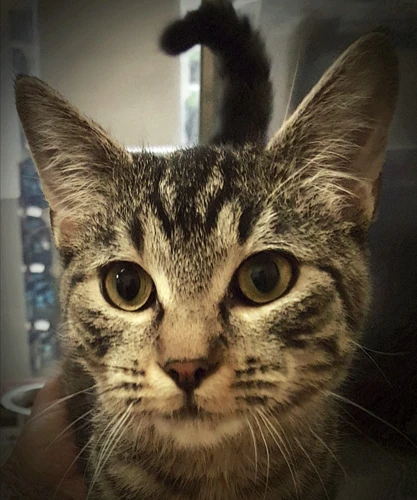
The evolution of feline exhibition shows can be traced back to ancient Egypt, where cats were worshiped and admired for their beauty and grace. Moving forward to the 1800s, domestic cats began to be shown in England and by the late 1800s, cat shows had spread to the United States. The first recorded cat show in America was held in 1895 at Madison Square Garden in New York City.
Cat shows continued to grow in popularity over the years, with the formation of organizations such as the Cat Fanciers’ Association (CFA) and The International Cat Association (TICA). This allowed for more standardized rules and criteria for judging and exhibiting cats at shows.
In the early days, cat shows were primarily focused on the appearance of the cats, with judges focusing on physical attributes such as eye color and coat texture. However, as cat shows grew in popularity, more emphasis was placed on a cat’s temperament and overall health.
Today, feline exhibition shows are highly organized events that draw in cat lovers from all over the world. They provide a platform for breeders to showcase their cats and for cat enthusiasts to learn about different breeds and connect with like-minded individuals.
As feline exhibition shows have evolved, so too has the American Bobtail’s role in them. With their striking appearance and unique personality traits, American Bobtails have become a popular breed for cat shows. They have made a significant impact on feline exhibition shows, showing that even non-pedigreed cats can excel in competitions.
CFA and TICA
The Cat Fanciers’ Association (CFA) and The International Cat Association (TICA) are two notable organizations in the feline world that oversee cat shows and maintain breed standards. Both organizations are renowned for their rigorous standards and stringent evaluation processes. CFA was founded in 1906 with the mission of preserving the pedigree of cats, with TICA following in 1979.
The Cat Fanciers’ Association (CFA) is the world’s largest registry of pedigreed cats and is considered to be the most prestigious cat registry in the world. The CFA recognizes over 40 different breeds of cats, including the American Bobtail. CFA judges evaluate the cats based on their adherence to breed standards, which include physical characteristics and personality traits. To become a CFA-registered breeder or exhibitor, one must follow a strict set of rules and regulations, such as exhibiting only CFA-registered cats, adhering to vaccination and health guidelines, and more.
The International Cat Association (TICA) is a non-profit organization that focuses on promoting the welfare of cats and preserving distinct breeds. TICA’s objective is to champion all cats, regardless of breed or ancestry, and provide a platform for showing and evaluating cats in a fun and friendly environment. The organization recognizes over 70 breeds of cats, including American Bobtails, and evaluates cats based on a written breed standard that describes their ideal physical and personality characteristics. TICA judges also evaluate the cats based on their grooming and condition, temperament, and behavior in the show ring.
Both CFA and TICA offer the opportunity for breeders and exhibitors to showcase their cats and compete for prestigious titles such as champion, grand champion, and more. Their established standards for evaluating cats provide a level playing field for breeders and exhibitors around the world, allowing them to gauge their breeding program’s success and earn recognition for their hard work.
American Bobtail’s Impact on Feline Shows
It’s quite interesting to explore the impact of the American Bobtail breed on feline shows. This breed has certainly made a mark on the world of cat exhibitions. It’s a breed that offers a lot of variety, having both long- and short-haired members with different color combinations. They bring a unique character to the arena with their friendly and outgoing demeanor.
The American Bobtail has made an impression on judges and cat enthusiasts worldwide, thanks to its remarkable appearance, temperament, and stunning athletic ability. This breed has snatched a share of limelight from perennial favorites like Persians, Siamese, and Maine Coons. Judges today are choosing quality over quantity, and this unconventional yet beautiful breed is a great example of that.
The breed’s impressive agility and well-muscled body have made it a favorite among feline athletes. Its surprisingly wild appearance adds flavor to breed classes and attracts a lot of attention. But beyond the breed’s physical attributes, its outgoing and sociable nature increases its popularity amongst competitors and judges.
The popularity of the American Bobtail has grown significantly in recent years. They have become a favorite of breeders and enthusiasts alike, with more and more people seeking to own these cats. This popularity has not gone unnoticed in feline exhibition shows, where the breed is increasingly being offered showing opportunities.
One of the most notable events where American Bobtails have made an impact is the International Cat Association (TICA) awards show. They have consistently been among the most competitive breeds in the TICA shows, with many American Bobtails consistently taking home top honors.
American Bobtails are a breed on the up, with ever-increasing popularity. Breeders nowadays put extra care into breeding and raising the best quality cats, in a bid to create champions, with exceptional breed standards that meet the competition requirements.
The American Bobtail has had a significant impact on feline exhibition shows, attracting the interest of breeders and enthusiasts worldwide. With their unique appearance, social disposition, and athletic ability, they are steadily climbing the competition ranks in shows like TICA. Their popularity and impact will continue to grow and shape the feline show circuit in the years to come.
American Bobtail Championship Criteria
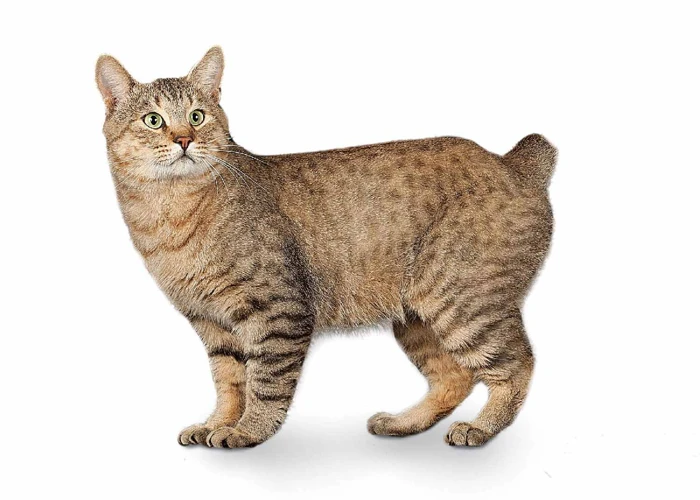
To become a champion American Bobtail in feline exhibition shows, there are certain criteria that the cat must meet. The Cat Fanciers’ Association (CFA) and The International Cat Association (TICA) both have specific standards for the breed.
CFA Standards: To achieve championship status in CFA shows, American Bobtails must have a sturdy, well-proportioned body with a broad chest and short tail. The tail should be no shorter than one inch and no longer than three inches. Additionally, the head should be broad with large, almond-shaped eyes and a distinct whisker pad. The coat should be dense and resilient, with a variety of colors and patterns accepted. Judges will also evaluate the cat’s temperament, with friendly and outgoing personalities being preferred.
TICA Standards: TICA has similar criteria for championship status, but they also recognize the long-haired American Bobtail. The body should be muscular and athletic, with a gentle curve to the back. The head should be a modified wedge with large, wide-set ears. The coat should be dense and plush, with a variety of colors and patterns accepted. Judges will also evaluate the cat’s temperament, with outgoing and affectionate personalities being preferred.
In addition to these physical standards, American Bobtails must exhibit proper show etiquette. This includes being calm and relaxed during the judging process, not showing any signs of aggression or discomfort. Handlers should also present their cat to the judges in a professional manner, showcasing the cat’s best attributes.
Preparing for a show requires a lot of effort and dedication from both the cat and the handler. Grooming is an essential component, with the cat’s coat needing to be clean and well-maintained. Additionally, cats should be well-trained to allow handling and examination by the judges. Practices such as these will help the American Bobtail excel in feline exhibition shows and reach championship status.
The American Bobtail has made a significant impact in the feline exhibition show world. With distinct physical attributes and a friendly personality, it’s no wonder they have become a favorite among breeders and judges alike. By following the established criteria and proper show etiquette, American Bobtails can continue to succeed on the road to becoming a champion.
CFA and TICA Standards
When it comes to competing in feline exhibition shows, it is important to understand the standards set by the Cat Fanciers’ Association (CFA) and The International Cat Association (TICA). These standards serve as a guideline for judges to evaluate a cat’s physical attributes, temperament, and overall aesthetic appeal.
CFA Standards: According to the CFA, the American Bobtail should have a wild appearance, with a sturdy and muscular body. The head should be wide and in proportion to the body, with a strong chin and high cheekbones. The eyes should be almond-shaped and should complement the coat color. The tail should be short and may be straight, slightly curved, or have a kink, which is a defining characteristic of the breed.
In terms of coat type, the CFA recognizes two varieties of American Bobtail: shorthair and longhair. The shorthair has a straight, dense coat, while the longhair has a soft, silky coat that is longer on the ruff, tail, and britches. The CFA recognizes all colors and patterns for the American Bobtail.
TICA Standards: The TICA also recognizes the American Bobtail and has its own set of standards for the breed. The TICA places more emphasis on the cat’s personality and behavior than the CFA does. According to the TICA, the American Bobtail should be friendly, outgoing, and interactive with their owners and other cats. They should also be agile and athletic, with a strong hunting instinct.
Physically, the TICA standards are similar to the CFA standards, with a muscular body and short, kinked tail. The head should be broad and have a square appearance when viewed from the front. The eyes should be large and expressive, with a color that complements the coat color. The TICA also recognizes both shorthair and longhair varieties and all colors and patterns for the American Bobtail.
Understanding the standards set by the CFA and TICA is essential for anyone looking to show their American Bobtail. These standards serve as a guideline for breeders, judges, and exhibitors to ensure that the breed remains true to its unique characteristics and remains competitive in the world of feline exhibition shows.
American Bobtail Show Etiquette
The world of feline exhibition shows is a highly competitive and formalized environment, with strict guidelines and expectations for both the cats and their handlers. As a handler of an American Bobtail competing in these shows, it is important to understand the etiquette and standards expected of participants.
Behavior: Handlers are expected to display good sportsmanship and professionalism at all times, including during times of high stress or disappointment. Yelling or physically disciplining the cat is strictly prohibited and will result in disqualification. Handlers must also be mindful of their cat’s behavior and ensure that they are not disruptive or aggressive towards other cats or people.
Presentation: The appearance of both the cat and handler are judged in these shows. Handlers should aim to present themselves in a neat, clean, and professional manner, wearing formal attire and minimal jewelry. The cat’s coat should be clean and well-groomed, and their nails should be neatly trimmed. It is also important to ensure that the cat is comfortable and relaxed during the presentation.
Timing: Proper timing is crucial in these shows. Handlers should ensure that they arrive early to complete all necessary paperwork and registration procedures. Prior to the start of the show, handlers must present their cat to the judges for examination. During the competition, handlers must be ready to present their cat when called upon and obey all time limits set by the judges.
Respect: Respecting the judges, other exhibitors, and the cats themselves is crucial in these shows. Handlers should refrain from speaking ill of another cat or their handler, and avoid engaging in any form of gossip or drama. Respectfully addressing judges and thanking them for their time is also important, as is congratulating other winners and participants.
Adhering to these American Bobtail show etiquette standards is essential in order to successfully compete in feline exhibition shows. It demonstrates not only a commitment to the competition, but also a respect for the cats and the other participants. As a handler, following these guidelines is a show of respect for the breed and can set the tone for future shows and competitions.
The Road to Becoming a Champion
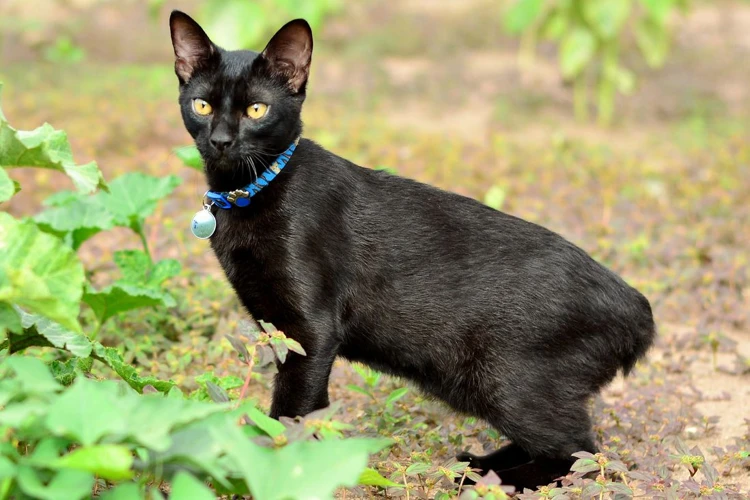
Becoming a champion in Feline Exhibition Shows is a significant achievement for any cat breed, including the American Bobtail. The road to becoming a champion requires dedication, hard work, and a deep understanding of the show circuit.
Preparing for Shows: Before competing in any show, American Bobtail owners must prepare their cats for the experience. This includes proper grooming, health checks, and acclimation to the show environment. American Bobtails should be regularly groomed to present a neat and clean appearance.
Exhibition Show Timeline: The exhibition show timeline is divided into several stages. The first stage is the entry process, where owners submit their cats’ information to the show organizers. The second stage is the check-in process, which includes a veterinary inspection to ensure that all cats are healthy and meet the show’s requirements. The third stage is the judging process, where the cats are assessed against the breed standard. The final stage is the awards ceremony, where the champions are announced.
CFA and TICA Standards: The Cat Fanciers’ Association (CFA) and The International Cat Association (TICA) are the two main organizations overseeing Feline Exhibition Shows. They have specific criteria that American Bobtails must meet to become champions. CFA and TICA standards include physical attributes, temperament, and personality.
American Bobtail Show Etiquette: American Bobtail owners must follow proper etiquette during the exhibition show. This includes being prompt and respectful to judges, maintaining good sportsmanship, and not interfering with other exhibitors’ cats. Owners should also maintain a professional attitude and present their cats in the best possible manner.
Becoming a champion in the Feline Exhibition Shows is a feat that requires a lot of hard work, dedication, and preparation. American Bobtail owners must follow proper etiquette, adhere to CFA and TICA standards, and have a deep understanding of the exhibition show timeline to maximize their chances of success.
Preparing for Shows
Participating in a cat show can be thrilling yet nerve-wracking for any cat owner, and preparing for the show is crucial. A well-prepared American Bobtail has a higher chance of winning and impressing the judges.
Start Early: Preparing for a cat show should begin long before the event. Select the show that will fit your schedule and register your cat with the cat club organizing the event. Also, ensure that your cat has a current health certificate, as it is a requirement for most shows.
Practice Grooming: Grooming is a critical aspect of cat shows, and it’s important to start grooming your cat weeks before the event. It is also essential to trim your cat’s nails regularly to prevent damage to the show’s props.
Training: Training your American Bobtail to be comfortable with handling can be a game-changer. Get your cat used to being handled by strangers, just as the judges would during the competition. You can achieve this by exposing your cat to different grooming techniques, sounds, and environments.
Dress Rehearsals: Consider the competition area and practice walking your cat in various environments similar to the show; this can help your cat feel more relaxed and comfortable when it’s time to showcase. Also, practice holding your cat in the position required by the judges and get your cat used to be combed, brushed, and handled by strangers.
Supplies: Ensure you have everything you’ll need on the day of the show. These include grooming supplies, food, clean water, and your cat’s favorite toys, among others. Start packing these supplies days before the event.
Remember to stay calm and positive; the cat can sense our emotions, so a relaxed, positive attitude can help your cat relax and enjoy the show day. Following these steps can help you and your cat have a hassle-free and enjoyable cat show experience.
Exhibition Show Timeline
Attending a feline exhibition show can be an exciting experience for both owners and breeders of American Bobtail cats. However, it is important to understand the timeline of events before the actual show to ensure a successful and stress-free day.
Several Weeks Before the Show
Owners and breeders should take the time to prepare their American Bobtail cats for the exhibition show. This includes grooming and practicing tricks or commands to showcase their personality during the judging process. It is also essential to finalize any necessary paperwork and registration forms with the show organizers to avoid any last-minute surprises.
The Day Before the Show
On the day before the exhibition show, owners and breeders should spend ample time grooming their American Bobtail cats and packing any necessary supplies such as food, water, and toys. It is critical to ensure that the cats are clean and comfortable since they will be spending a lot of time in their cages while waiting for their turn to compete. It is also advisable to scope out the show venue to get a sense of the layout and familiarize yourself with the judging process.
The Day of the Show
On the day of the exhibition show, owners and breeders should arrive at the venue early to allow their American Bobtail cats to settle down and adjust to their surroundings. It is essential to ensure that the cats are hydrated and fed at regular intervals to keep them calm and relaxed. During the judging process, breeders should display their cats in cages and be prepared to answer any questions from the judges regarding the cat’s breed, temperament, and grooming.
The Aftermath of the Show
After the exhibition show, owners and breeders should take the time to debrief and evaluate their performance. It is crucial to understand and analyze the judges’ feedback to improve for future exhibitions. Additionally, ensure that the American Bobtail cats receive plenty of rest and love after a long day of competing.
By following this exhibition show timeline, owners and breeders of American Bobtail cats can ensure that the experience is both positive and rewarding for both the cats and their owners.
American Bobtail Breeders and Clubs
Finding a reputable breeder is essential when looking for a new pet, and the same goes for the American Bobtail breed. Fortunately, there are plenty of breeders across the United States that specialize in this beloved breed.
Cattery Listings: One way to locate American Bobtail breeders is through cattery listings. These listings are typically organized by state and offer a comprehensive list of breeders in that area. Websites like the American Bobtail Cat Club’s breeder directory or the Cat Fanciers’ Association’s breeder referral service are great places to start your search. Another great resource is the TICA (The International Cat Association) website.
Breed-Specific Clubs: Another great way to connect with American Bobtail breeders is by joining a breed-specific club. The American Bobtail Cat Club, for example, is a community of American Bobtail enthusiasts that shares information and resources with members. The club is also a great resource for learning more about the breed and its history. Additionally, breed-specific clubs can provide opportunities to attend shows or events, network with other American Bobtail owners, and receive support and advice from experienced breeders.
It’s important to note that not all breeders are created equal. When searching for a breeder, be sure to do your research and ensure that the breeder adheres to ethical breeding practices. A reputable breeder will be happy to discuss their breeding methods, provide health certificates for their cats, and allow potential buyers to visit their cattery.
There are many ways to connect with American Bobtail breeders, including cattery listings, breed-specific clubs, and networking at shows or events. As with any pet purchase, it’s important to do your research and find a reputable breeder that prioritizes the health and well-being of their cats.
Cattery Listings
Cattery Listings
If you’re interested in the American Bobtail breed, finding a reputable and responsible breeder is essential. A responsible breeder will have a deep understanding of their cats’ lineage and will prioritize the health and wellbeing of their cats over monetary gain. You can start your search by exploring cattery listings.
Cattery listings can be found online and provide information about breeders that specialize in American Bobtail cats. These listings allow you to explore each breeder’s website and see pictures of their cats, learn about their breeding program, and contact them directly with any questions.
When searching for a reputable breeder through cattery listings, look for those who have been certified by the Cat Fanciers Association (CFA) or The International Cat Association (TICA). These organizations work to ensure that breeders meet certain standards for cat care and breeding practices.
Additionally, it’s important to consider the breeder’s reputation in the cat breeding community. You can do this by asking for references and speaking to others who have purchased a cat from the breeder. A breeder with a positive reputation is more likely to have healthy and well-socialized kittens.
Remember, adopting a cat from a reputable breeder not only gives you the best chance of finding a healthy and happy American Bobtail, but it also supports responsible breeding practices that prioritize cats’ welfare.
Take your time when searching through cattery listings and doing research on potential breeders. Finding the right cat and breeder can take patience, but it’s worth it to ensure that you have a lifelong companion that brings you joy and happiness.
Breed-Specific Clubs
If you’re interested in the American Bobtail breed and want to connect with other enthusiasts, joining a breed-specific club can be a great way to do it. These types of clubs are dedicated to the American Bobtail breed specifically, and they provide a wonderful opportunity for breeders, pet owners, and anyone else who’s interested in the breed to connect and share their knowledge.
Benefits of Joining a Breed-Specific Club
When you join a breed-specific club, you’ll have access to a wealth of information about the American Bobtail breed. You’ll be able to connect with other people who own or breed American Bobtails and get advice and tips from experienced members. You’ll also be able to attend breed-specific events and shows, where you can learn more about the breed and meet other enthusiasts.
How to Find a Breed-Specific Club
There are a number of breed-specific clubs dedicated to the American Bobtail breed. A quick Google search will turn up several options, but it’s a good idea to do some research before joining any particular club. Look for clubs that have an active membership base and participate in shows and events.
Getting Involved with a Breed-Specific Club
Once you’ve found a breed-specific club that you’re interested in joining, the next step is to get involved. Attend meetings, participate in events and shows, and connect with other members. The more you get involved, the more you’ll learn about the American Bobtail breed and the more connected you’ll feel to the community of people who share your passion.
Conclusion
Joining a breed-specific club can be a wonderful way to connect with other American Bobtail enthusiasts, learn more about the breed, and get involved in shows and other events. Whether you’re a breeder or a pet owner, being part of a community of like-minded individuals can be a rewarding and fulfilling experience. Consider joining a breed-specific club today and see what it can do for you!
Conclusion
After all the information presented, it is undeniable that the American Bobtail breed plays a significant role in feline exhibition shows. Their unique physical attributes, charming temperament, and distinctive coat colors make them stand out among the other breeds.
Through the decades, feline shows have evolved from simple cat competitions to prestigious events that draw cat lovers from all over the world. The Cat Fanciers’ Association (CFA) and The International Cat Association (TICA) both recognize the American Bobtail as a championship breed, solidifying its place in feline exhibition shows.
To become a champion American Bobtail, a cat must meet specific criteria outlined by the CFA and TICA standards. Owners must also abide by proper show etiquette to ensure a fair and enjoyable experience for all involved.
For those interested in the American Bobtail breed, there are reputable breeders and breed-specific clubs available. These resources can provide valuable information for those considering adding an American Bobtail to their family or pursuing a life on the exhibition show circuit.
In conclusion, the American Bobtail breed adds a touch of charm and uniqueness to feline exhibitions. Their distinctive characteristics and impact on the show circuit are a testament to the breed’s beauty and intelligence. Whether you’re a cat enthusiast or just appreciate their charm, the American Bobtail is definitely a breed worth admiring.
Frequently Asked Questions
What makes the American Bobtail breed stand out among other cat breeds?
The American Bobtail breed is known for its unique physical attributes, including a short bobbed tail and wild appearance. They are also highly sociable and have a friendly personality.
Can American Bobtails compete in other cat shows besides those specifically for their breed?
Yes, American Bobtails can compete in all kinds of cat shows. However, it’s important to note that their breed standards and criteria may differ from the standards of the particular show in which they are competing.
What kind of temperament does an American Bobtail have compared to other cat breeds?
American Bobtails are known for being friendly, sociable, and affectionate. They are also highly intelligent, making them trainable and adaptable to different environments.
What are the most common coat types and colors of American Bobtails?
The most common coat types are short-haired and medium-haired. Colors vary widely, but some of the most popular are brown tabby, black, and white.
What specific criteria do American Bobtails need to meet to be recognized as champions?
American Bobtails must meet the breed standards set by organizations such as CFA and TICA. These standards include physical attributes, temperament, and overall health.
What should I expect if I decide to attend an American Bobtail exhibition show?
At an American Bobtail exhibition show, you can expect to see a variety of cats from different catteries and breeders. You can also learn more about the breed and interact with other cat enthusiasts.
What should I do to prepare my American Bobtail for an exhibition show?
Your American Bobtail should be in good health and have all necessary vaccinations before being entered into a show. You should also groom your cat to ensure it looks its best.
Are there any specific etiquettes I should follow when attending an American Bobtail exhibition show?
It’s important to be respectful of others at the show and to follow any guidelines set by the show organizers. Avoid touching or interacting with cats without the owner’s permission.
Where can I find reputable American Bobtail breeders and catteries?
You can find a list of reputable breeders and catteries through organizations such as CFA and TICA. It’s also a good idea to research online and ask for recommendations from other cat owners.
Are there any specific health issues I should be aware of with the American Bobtail breed?
While the American Bobtail breed is generally healthy, dental issues and hip dysplasia can sometimes occur. It’s important to keep up with regular checkups and consulting with a veterinarian for any related health concerns.

